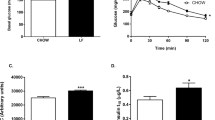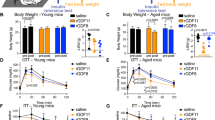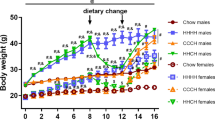Abstract
Yellow KK mice carrying the 'yellow obese' gene Ay are a well established polygenic model for human non–insulin dependent diabetes mellitus. These animals develop marked adiposity and decreased glucose tolerance relative to their control littermates, KK mice. The authors monitored glucose tolerance in KK-Ay mice over time and observed a significant (P ≤ 0.05) age-dependent improvement (13.3% by 175 d of age and 36.4% by 212 d of age, relative to 85 d of age). During the same time period, body weight and food and water consumption were relatively constant. The authors also measured plasma levels of endocrine hormones that are important in diabetes. Levels of insulin were approximately 8 times higher and levels of amylin 3 times higher in 220-d-old KK-Ay mice than in 180-d-old mice, whereas levels of glucagon-like peptide 1, glucagon and leptin remained relatively constant. These findings suggest that KK-Ay mice undergo an age-dependent improvement of glucose tolerance when maintained on a normal diet for 25 weeks or longer, due in part to increases in plasma levels of insulin and amylin.
This is a preview of subscription content, access via your institution
Access options
Subscribe to this journal
We are sorry, but there is no personal subscription option available for your country.
Buy this article
- Purchase on Springer Link
- Instant access to full article PDF
Prices may be subject to local taxes which are calculated during checkout



Similar content being viewed by others
References
Keen, H. & Ng, T.F.S. The definition and classification of diabetes mellitus. Clin. Endocrinol. Metab. 11, 279–305 (1982).
Ziv, E., Shafrir, E., Kalman, R., Galer, S. & Bar-On, H. Changing pattern of prevalence of insulin resistance in Psammomys obesus, a model of nutritionally induced type 2 diabetes. Metabolism 48, 1549–1554 (1999).
Zimmet, P. & Albert, K.G.M.M. Shaw, J. Global and societal implications of the diabetes epidemic. Nature 414, 782–787 (2001).
Ghosh, S. & Schork, N.J. Genetic analysis of type II diabetes: the analysis of quantitative traits. Diabetes 45, 1–14 (1996).
Ross, S.A., Gulve, E.A. & Wang, M. Chemistry and biochemistry of type 2 diabetes. Chem. Rev. 104, 1255–1282 (2004).
Kahn, C.R., Vicent, D. & Doria, A. Genetics of non-insulin-dependent (type-II) diabetes mellitus. Annu. Rev. Med. 47, 509–531 (1996).
DeFronzo, R.A. Insulin resistance: a multifaceted syndrome responsible for NIDDM, obesity, hypertension, dyslipidaemia and atherosclerosis. Neth. J. Med. 50, 191–197 (1997).
Doolittle, D.P., Davisson, M.T., Guidi, J.N. & Green, M.C. Catalog of mutant genes and polymorphic loci. in Genetic Variants and Strains of the Laboratory Mouse vol. 1 (Lyon, M.F., Rastan, S. & Brown, S.D.M., eds.) 3rd edn. (Oxford, New York, 1996).
Kondo, K.K., Nozawa, T., Tomida, T. & Ezaki, K. Inbred strains resulting from Japanese mice. Bull. Exp. Anim. 6, 107–112 (1957).
Nishimura, M. Breeding of mice strains for diabetes mellitus. Exp. Anim. (Japan) 18, 147–157 (1969).
Fan, W., Boston, B.A., Kesterson, R.A., Hruby, V.J. & Cone, R.D. Role of melanocortinergic neurons in feeding and the agouti obesity syndrome. Nature 385, 165–168 (1997).
Miller, M.W. et al. Cloning of the mouse agouti gene predicts a secreted protein ubiquitously expressed in mice carrying the lethal yellow mutation. Genes Dev. 7, 454–467 (1993).
Lu, D. et al. Agouti protein is an antagonist of the melanocyte-stimulating hormone receptor. Nature 371, 799–802 (1994).
Millar, S.E., Miller, M.W., Stevens, M.E. & Barsh, G.S. Expression and transgenic studies of the mouse agouti gene provide insight into the mechanisms by which mammalian coat color patterns are generated. Development 121, 3223–3232 (1995).
Manne, J., Argeson, A.C. & Siracusa, L.D. Mechanisms for the pleiotropic effects of the agouti gene. Proc. Natl. Acad. Sci. (USA) 92, 4721–4724 (1995).
Leiter, E.H., Reifsnyder, P.C., Xiao, Q. & Mistry, J. Adipokine and insulin profiles distinguish diabetogenic and non-diabetogenic obesities in mice. Obesity 15, 1961–1968 (2007).
Braithwaite, S.S., Palaznk, B., Colca, I.R., Edward, C.W. & Hoffman, C. Reduced expression of hexokinaseII in insulin-resistant diabetic. Diabetes 44, 4–48 (1995).
Kato, M., Suwa, T. & Shimokawa, T. Glucose catabolic gene m-RNA levels in skeletal muscle exhibit non-coordinate expression in hypoglycemic mice. Horm. Metab. Res. 36, 513–518 (2004).
Diani, A.R. et al. Analysis of pancreatic islet cells and hormone content in the spontaneously diabetic KKAy mouse by morphometry, immunocytochemistry and radioimmunoassay. Virchows Arch. A Pathol. Anat. Histol. 412, 53–61 (1987).
Chakraborty, G. et al. Peanut oil lowers blood glucose in models of type II but not type I diabetic mice. Diabetes. 65th Scientific Sessions Abstract Book Supplement, Abstract 2678-PO (2005).
Kesty, N.C., Roth, J.D. & Maggs, D. Hormone-based therapies in the regulation of fuel metabolism and body weight. Expert Opin. Biol. Ther. 8, 1733–1747 (2008).
Mao, X.-Q. et al. Astragalus polysaccharide reduces hepatic endoplasmic reticulum stress and restores glucose homeostasis in a diabetic KKAy mouse model. Acta Pharmacologica Sinica 28, 1947–1956 (2008).
Takada, K. et al. Islet amyloid polypeptide/amylin contents in pancreas change with increasing age in genetically obese and diabetic mice. Diabetes Res. Clin. Pract. 33, 153–158 (1996).
Oyama, K. et al. Spontaneous recovery from hyperglycemia by regeneration of pancreatic β-cells in Kir6.2G132S transgenic mice. Diabetes 55, 1930–1938 (2006).
Acknowledgements
This work was supported by a Research Corporation Cottrell College Science Award and by the Margaret and Herman Sokol endowment. D.-E.L. was supported by the Ronald E. McNair Post-Baccalaureate Achievement Program. We thank Ernest Rogers, DVM, PhD, for his expertise and supervision of our mouse studies.
Author information
Authors and Affiliations
Corresponding author
Ethics declarations
Competing interests
The authors declare no competing financial interests.
Rights and permissions
About this article
Cite this article
Chakraborty, G., Thumpayil, S., Lafontant, DE. et al. Age dependence of glucose tolerance in adult KK-Ay mice, a model of non–insulin dependent diabetes mellitus. Lab Anim 38, 364–368 (2009). https://doi.org/10.1038/laban1109-364
Received:
Accepted:
Issue Date:
DOI: https://doi.org/10.1038/laban1109-364
This article is cited by
-
Nilpotent Singularities and Periodic Perturbation of a \(GI\beta \) Model: A Pathway to Glucose Disorder
Journal of Nonlinear Science (2023)



